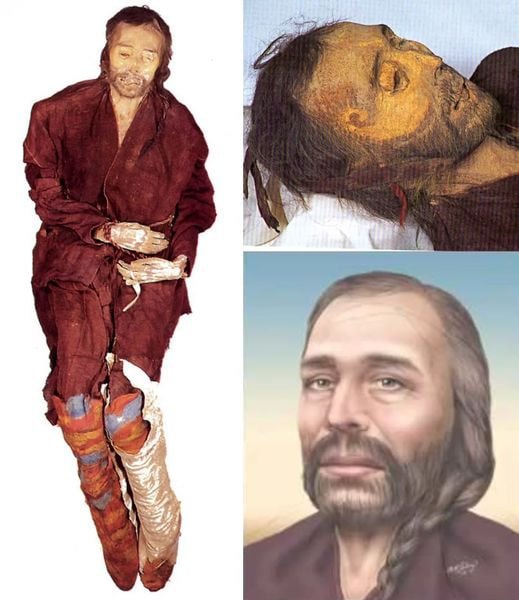Cherchen Man (1000 BC) & Uighur Tarim Tocharians
Cherchen Man or Chärchän Man is a mummy discovered in the Taklamakan Desert, Xinjiang Uighur Autonomous Region, western China. Cherchen Man “died around 1000 BC”. …tests showed that he had probably roamed the Tarim Basin as early as the 11th C. BC. The mummy is described as: a 3,000 year old male, “6-foot-6-inch giant with Caucasian features”, with hair that is “reddish brown flecked with grey, framing high cheekbones”, an “aquiline” “long nose, full lips and a ginger beard”, whose face is tattooed with “yellow and purple patterns”, it wears “a red twill tunic and tartan leggings”; it is also described as looking “like a Bronze Age European”, “a Celt”. The Tarim Basin mummies are not limited to men. A female mummy was also found and is called Cherchen Woman.

A warrior of the Caledonii tribe, the man’s hair is reddish brown flecked with grey, framing high cheekbones, a long nose, full lips and a ginger beard. When he lived three thousand years ago, he stood six feet tall, and was buried wearing a red twill tunic and tartan leggings. He looks like a Bronze Age European. In fact, he’s every inch a Celt. Even his DNA says so….DNA testing confirms that he and hundreds of other mummies found in Xinjiang’s Tarim Basin are of European origin. We don’t know how he got there, what brought him there, or how long he and his kind lived there for. But, as the desert’s name suggests, it is certain that he never came out…… the weave of the cloth is the same as that of those found on the bodies of salt miners in Austria from 1300BC…….A female mummy wears a long, conical hat which has to be a witch or a wizard’s hat. Or a druid’s, perhaps? The wooden combs they used to fan their tresses are familiar to students of ancient Celtic art……At their peak, around 300BC, the influence of the Celts stretched from Ireland in the west to the south of Spain and across to Italy’s Po Valley, and probably extended to parts of Poland and Ukraine and the central plain of Turkey in the east. These mummies seem to suggest, however, that the Celts penetrated well into central Asia, nearly making it as far as Tibet…..The Celts gradually infiltrated Britain between about 500 and 100BC……The eastern Celts spoke a now-dead language called Tocharian, which is related to Celtic languages and part of the Indo-European group. They seem to have been a peaceful folk, as there are few weapons among the Cherchen find and there is little evidence of a caste system…….Even older than the Cherchen find is that of the 4,000-year-old Loulan Beauty, who has long flowing fair hair and is one of a number of mummies discovered near the town of Loulan. One of these mummies was an eight-year-old child wrapped in a piece of patterned wool cloth, closed with bone pegs…….The Loulan Beauty’s features are Nordic. She was 45 when she died, and was buried with a basket of food for the next life, including domesticated wheat, combs and a feather……From around 1800BC, the earliest mummies in the Tarim Basin were exclusively Caucausoid, or Europoid…..Many Uighurs consider the Han Chinese as the invaders……Best preserved of all the corpses is Yingpan Man, known as the Handsome Man, a 2,000-year-old Caucasian mummy discovered in 1995. He had a gold foil death mask – a Greek tradition – covering his blond, bearded face, and wore elaborate golden embroidered red and maroon wool garments with images of fighting Greeks or Romans. The hemp mask is painted with a soft smile and the thin moustache of a dandy. Currently on display at a museum in Tokyo, the handsome Yingpan man was two metres tall (six feet six inches), and pushing 30 when he died. His head rests on a pillow in the shape of a crowing cockerel. “….

We see the mummified so called “Cherchen man” and his boots.
These boots are still used by Central Asiatic riders.
“Mair spied a bizarre sight. It was the outstretched body of a man just under six feet tall, dressed in an elegantly tailored wool tunic and matching pants, the colour of red wine. Covering the man’s legs were striped leggings in riotous shades of yellow, red, and blue, …”
He wore on his feet patraongden boots from Shangshung, with golden flourishes. The sides of the boots were inlaid with diamonds….On his feet he wore Shangshung boots, Array of Nine Braveries, embroidered with beautiful rainbow designs, drawn designs of impressive armor, and bound by hard, solid meteoric iron nails……A splendid white silk scarf with golden rainbow designs was tied around its neck….On his head was a white turban
The body of the Cherchen man found in 1978, at a burial site in East Turkistan, was immaculately preserved. This man who lived about 3,000 years ago was most probably a shaman, guessing from the sun marking (tattoo) on the left side of his head. Most interestingly, the Cherchen Man was buried with no less than ten hats, even a conical “witch” hat – which is found as a common feature on several of these mummies. We saw that the Saka (Scythians) also wear pointed hats

Though it was commonly believed that the first contact between East Turkistan whose capital is Urumqi (Urumchi) and the West occurred relatively late in world history — around the middle of the second century B.C. — carbon dating has shown that the Cherchen man died 900 years earlier, indicating a much early expansion towards the west. The Uighur people who were expert riders could populate remote regions of the world due to their semi-nomadic lifestyle ….. Victor Mair, a specialist in the ancient corpses and co-author of “Mummies of the Tarim Basin”, said: Modern DNA and ancient DNA show that Turks, Uighurs, Kazaks, Krygyzs, all people of Central Asia are all mixed Caucasian and East Asian. The modern and ancient DNA tells the same story.
The Tocharians or Tokharians (/təˈkɛəriənz/ or /təˈkɑriənz/) were inhabitants of medieval oasis city-states on the northern edge of the Tarim Basin (modern Xinjiang, China). Their Tocharian languages (a branch of the Indo-European family) are known from manuscripts from the 6th to 8th centuries AD, after which they were supplanted by the Turkic languages of the Uyghur tribes. Some scholars have linked the Tocharians with the Afanasevo culture of eastern Siberia (c. 3500–2500 BC), the Tarim mummies (c. 1800 BC) and the Yuezhi of Chinese records, most of whom migrated from southern Gansu to BACTRIA in the 2nd century BC and then later to northwest India where they founded the Kushan Empire..
The Tocharians, living along the Silk Road, had contacts with the Chinese, the Persians, the Indians and Turkic tribes. They adopted Buddhism, which, like their alphabet, came from northern India in the 1st century of the 1st millennium, through the proselytism of Kushan monks. The Kushans and the Tocharians seem to have played a part in the Silk Road transmission of Buddhism to China. Many Tocharians apparently also practised some variant of Manichaeanism.”…….”Virtual Art Exhibit – The Tarim Basin”. University of Washington. ……..Xu, Wenkan 1996 “The Tokharians and Buddhism” In: Studies in Central and East Asian Religions 9
Ancient Mummies of the Tarim Basin
Discovering Early Inhabitants of Eastern Central Asia
The mummies of Eastern Central Asia (hereafter ECA) first entered my consciousness in the summer of 1988. I had heard about them in the 1970s, but until I came face to face with them, I did not have a sense of their enormous importance for the study of Eurasian prehistory and history. I had been to the regional museum in Ürümchi many times before, but a visit in 1988 left me stunned by the newly opened exhibition of Bronze Age and Early Iron Age mummies.

The Witches of Subeshi were buried wearing striking hats. Photograph by Jeffery Newbury
Were the Mummies Real?
Having passed through the black curtains that hung from the top of the door, I was somewhat suspicious, because the mummies looked too good to be true. The fact that they had light hair, fair skin, long noses, deepset eyes, and thin lips was also cause for pause. I thought that the mummies were part of an elaborate hoax perpetrated to drum up tourism. Yet the labels claimed the mummies dated to the 1st and 2nd millennia BCE. The artifacts accompanying them were also remarkably well preserved and, in many instances, technologically and culturally advanced. For example, the mummies had bronze, wheat, and the wheel before these appeared in the Central Plains of China, and their woolen textiles were of extraordinarily fine quality. The longer I stayed in that room full of mummies and carefully observed
them and their associated artifacts, my doubts gradually dissipated.

This mummy from Niya cemetery 95 (M5) has well-preserved blonde braids. Notice also the blue glass beads draped over her face.
Returning to Penn to resume my teaching duties, I set aside thoughts of the mummies until the September 1991 discovery of Ötzi, the 5,300-year-old, perfectly preserved Iceman (see article in this issue). Spurred by this discovery, I began to organize an international investigation to carry out research on the mummies of ECA. In the summer of 1993, I led my first expedition to the Tarim Basin. That initial expedition was focused on ancient DNA studies, but later expeditions would delve into textiles, bronze and iron metallurgy, agriculture, and other aspects of the existence of the earliest inhabitants of the region. Nearly three decades after that fateful encounter in the summer of 1988, I am still actively engaged in investigations on the Tarim mummies. To use a Chinese expression, the mummies of ECA and I “youyuan” (have an affinity).
Bodies Preserved in Dry, Cold Conditions
The human remains that I discuss here are not actually mummies, but rather desiccated corpses. Their uncanny state of preservation is not due to any artificial means—such as we find with the mummies of Egypt—but to the extreme aridity and saline soils of the environment. Severely cold winters also played a significant role in arresting the processes of putrefaction and decomposition of the human remains. The mummies are found in cemeteries located along the southern and eastern edges of the Taklamakan (one of the world’s largest and driest deserts), which sits in the center of the Tarim Basin.
The Tarim Basin is one of the most remote (far from oceans and seas along whose littorals early humans travelled) and last populated places on Earth. During the Paleolithic and Neolithic periods in ECA (before 2000 BCE), there is no evidence of permanent settlement in the Tarim Basin. From the Bronze Age (in ECA, starting around 2000 BCE) onward, however, the region was a key locus of interaction between western and eastern Eurasia. Hundreds of mummies have been recovered from the Tarim Basin, some of which I describe here.

Eastern Central Asia has an extremely dry environment, leading to the preservation of bodies in cemeteries such as Ördek’s Necropolis, not far from Loulan.
The Beauty of Loulan
Loulan is the fabled city near the vanished Lop Nor (“Lop Lake”) that lay in the northeastern corner of the Tarim Basin. The Beauty of Loulan is a comely woman who was among the first mummies to be discovered in the region. She has been dated to about 1800 BCE. Shortly after she was found in the late 1970s, she became a cause célèbre among the local Turkic-speaking Uyghur people who considered her their ancestor, which they believed gave them a prior claim to the region over the Han Chinese, who arrived about 2,000 years later.
Unfortunately, the Uyghurs themselves did not arrive in the Tarim Basin until nearly a millennium after the Han Chinese. Thus, the Beauty of Loulan embodies one of the many mysteries about the mummies, namely, if she were neither a Sinitic-speaking Chinese nor a Turkic-speaking Uyghur, what language did she speak? Evidence exists indicating she may well have spoken Tocharian, the second oldest (after Hittite) Indo-European language.

The Beauty of Loulan was buried wearing a warm cloak or shroud, a hat, and boots. Other grave goods included a wooden comb, a basket, and a winnowing tray.\

The Beauty of Xiaohe (ca. 1800–1500 BCE) is extremely well preserved. Her body was found wrapped is a wide woolen cloak. Courtesy of the Cultural Relics Bureau of Xinjiang and Wang Da-Gang.
The Beauty of Xiaohe
One of the more recently unearthed mummies, the Beauty of Xiaohe, was recovered from Ördek’s Necropolis, far out in the desert at Small River Cemetery No. 5 along the mostly dried up Xiaohe (“Small River”), during excavations in the early 21st century. When the cover of her boat coffin was removed, she was found wearing a magnificent white hat. The Beauty of Xiaohe dates to around the same period and to a similar culture as the Beauty of Loulan. Xiaohe is located roughly 120 kilometers to the west-south-west of Loulan. (For more on the Beauty of Xiaohe and other mummies featured in the Penn Museum’s Secrets of the Silk Road exhibition in 2011, see special issue of Expedition 52.3.)
Chärchän Man
Chärchän Man was recovered from a tomb near the village of Zaghunluq in Qiemo County, in the central portion of the southern edge of the Tarim Basin. The tomb is situated on a plateau with extremely saline soil, which enabled excellent preservation of textiles from the extensive cemetery. This site is considerably more recent than the two discussed above and dates to around 600 BCE.
By this time, colorful dyes were being used in textile production, allowing for a breathtaking variety of garments. This includes the burgundy clothing worn by Chärchän Man and his two wives. The robe on the main wife is so fine that it is hard to imagine how their weaving technology could have reached such an advanced stage by that time. In a small grave next to the main tomb, a baby was found wearing a shroud of the same burgundy color and a blue cashmere cap.
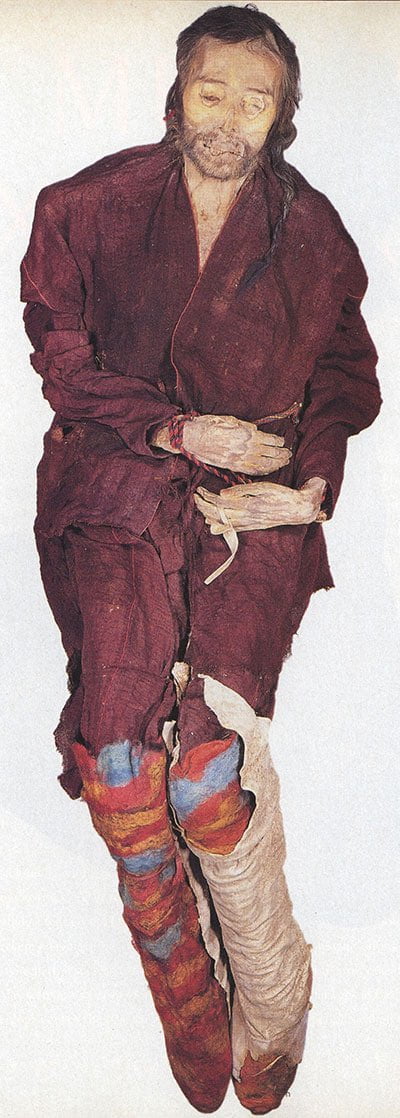
Chärchän Man wore burgundy-colored clothing. By ca. 600 BCE, textile production commonly used colorful dyes.
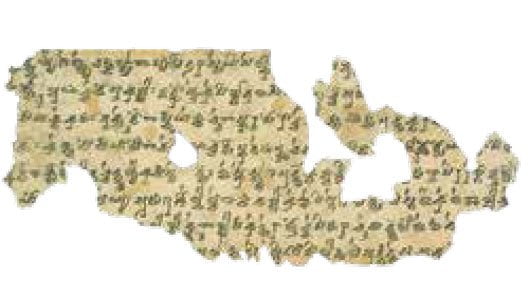
This fragment of Tocharian B writing is from Kucha, an ancient Buddhist kingdom located on the edge of the Tarim Basin. From Wikimedia Commons, public domain
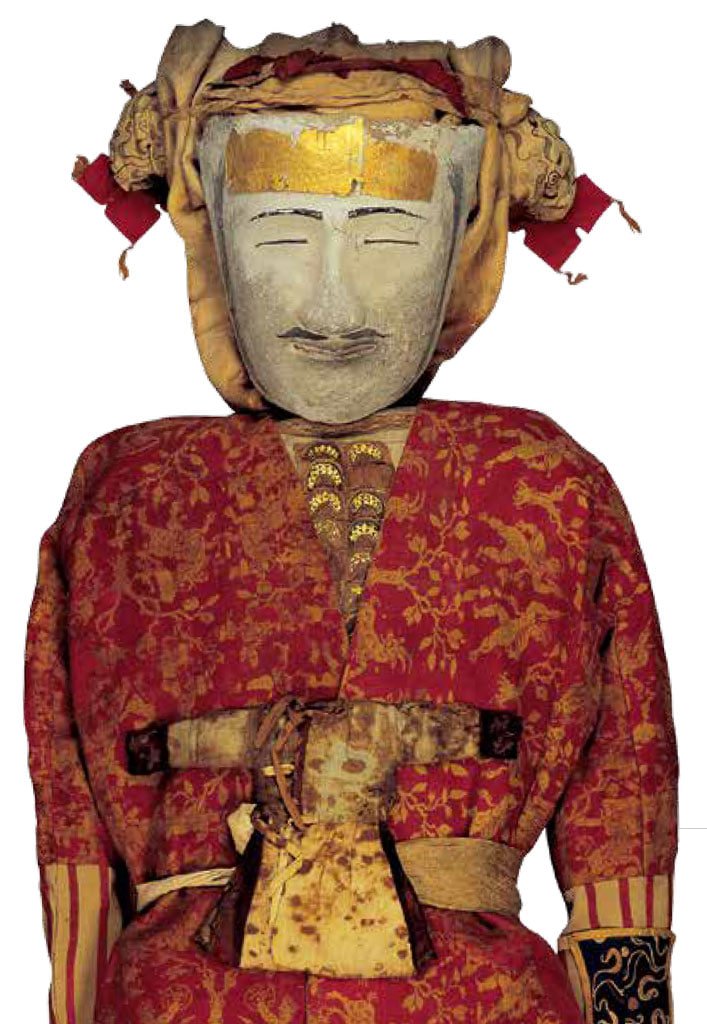
Yingpan Man wears a white mask and garments made from extraordinary textiles. Courtesy of the Cultural Relics Bureau of Xinjiang and Wang Da-Gang
Yingpan Man
Yingpan is located along an ancient caravan trail to the west of Turfan. Judging from his clothing and accessories, Yingpan Man must have been fabulously wealthy and is surely to be counted among the best dressed men of antiquity. Nearly 6’ 6” tall, Yingpan Man’s face is covered by a white mask with a strip of gold foil across the forehead. Yingpan Man’s amazing outfit, with its Greco-Roman motifs (including putti or cherubs and bulls with laurel wreaths around their midsection) and extravagant embroidery, marks him as a man of far-reaching connections.
Although his seriously decomposed body no longer lies within its sartorial shell, we know from earlier descriptions that he was a Caucasoid with brown hair. Considering his riches, international aura, and the strategic trading spot where he was buried, it is possible that Yingpan Man was a Sogdian merchant from a group of Middle Iranian people who were traders par excellence throughout Eurasia.
The Witches of Subeshi
The most intriguing mummies in ECA may be the “witches” of Subeshi, who wear very tall, pointed black hats that resemble the iconic headgear of their sisters in medieval Europe. Subeshi, dated to between the 4th and 2nd centuries BCE, is located in a high gorge just to the east of the important city of Turfan.
Historian and author Adrienne Mayor has recently suggested that the single heavy glove worn by one of the female mummies may indicate that she hunted with a raptor such as a golden eagle. A number of impressive male mummies have also been excavated at Subeshi, including a man who wears a felt helmet and another man whose chest has been stitched up with horse hair in what must be one of the oldest (4th century BCE) examples of surgery in the world.
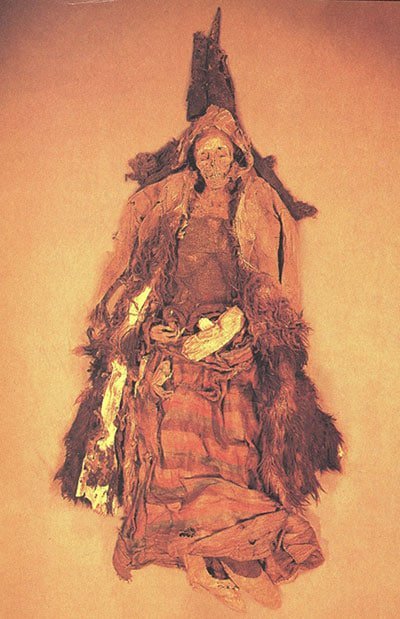
This Witch of Subeshi wears a heavy glove on one hand, perhaps an indication she hunted with raptors. Photograph courtesy of Jeffery Newbury.
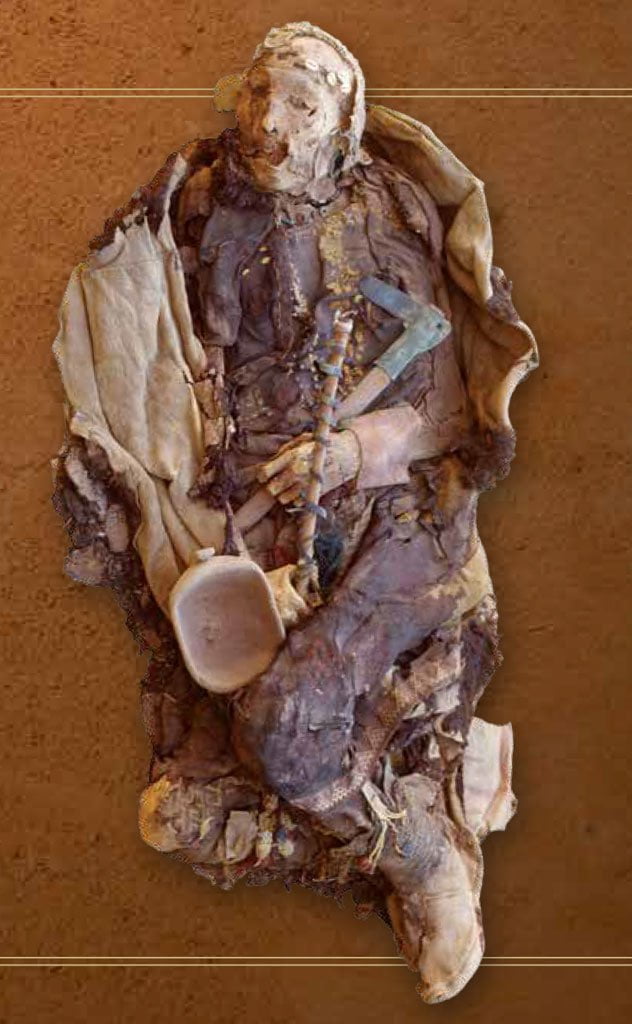
The Shaman of Yanghai
Going west through the Toyuq Gorge, where the site of Subeshi is located, and entering the flat, rocky desert land below, one comes to the vast series of cemeteries at Yanghai, which date to around 900 BCE. Among the mummies from Yanghai are a small boy whose chin is tucked under on his chest and a shaman-like figure with bells on his boots, who is smothered in cannabis.
Another man from Yanghai had a well-preserved harp by his side. Also recovered from Yanghai is the world’s first wooden leg prosthesis and many other wondrous finds, all of which have been described in the full excavation report by archeologist Lü Enguo.
The Man from Hami with a Dozen Hats
A man found at the Qizilchoqa cemetery near Wupu (“Fifth Burg”), about 60 km to the west of Hami (Qumul), appeared to have had an obsession with fancy, distinctive hats. Among the marvelous collection buried with him are a beret made of the world’s first nålebinding
(a technique like crocheting) and a Phrygian-style cap made of thick brown felt with striking white ornamental stitching. Also from this site are plaids employing the same weave (diagonal twill) as plaids from Celtic sites in Europe dating to around the same period (ca. 1000 BCE).
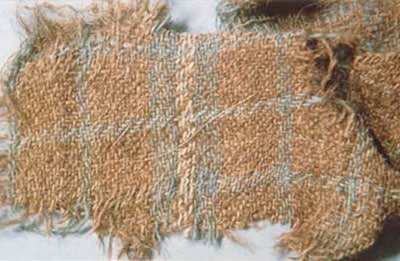
The “Hami fragment” of cloth resembles plaids from ancient central Europe. This textile was carefully studied by the late Irene Good, who held a Ph.D. from the University of Pennsylvania
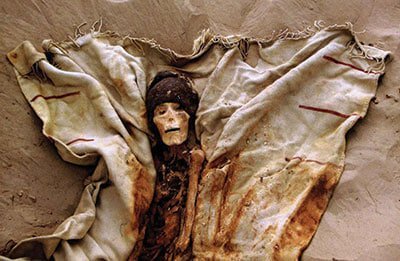
Textiles, such as this hat and blanket (or cloak) on a mummy from the Northern Cemetery—more than 600 km west of Ördek’s Necropolis—are preserved in the dry, cold climate of the Tarim Basin.
Research Continues
The early inhabitants of Eastern Central Asia did not belong to a single genetic and linguistic stock, nor did they come from a single source. They entered the Tarim Basin at different times and arrived from different directions— north, northwest, west, and southwest in the earlier periods; northeast, east, southeast, and south during later periods (though they also continued to come from the north, northwest, west, and southwest as well). Our research on the mummies of the Tarim Basin is still at its beginning stages. Many fascinating questions remain to be answered, yet we have already learned much about these prehistoric denizens who represent one of the most important sources of information about the development of Bronze Age and Early Iron Age civilization.
Victor H. Mair, PH.D. is Professor of Chinese Language and Literature in the Department of East Asian Languages and Civilizations at the University of Pennsylvania. He was curator of the 2011 Penn Museum exhibition Secrets of the Silk Road.
For Further Reading
Museum Publications, 1998.Mallory, J.P., and V.H. Mair. The Tarim Mummies: Ancient China and the Mystery of the Earliest Peoples from the West. London: Thames & Hudson, 2000.
Mair, V.H. “The Mummies of East Central Asia.” Expedition 52.3 (Winter 2010): 23-32.
Mair, V.H., ed. Secrets of the Silk Road: An Exhibition of Discoveries from the Xinjiang Uyghur Autonomous Region, China. Santa Ana, California: Bowers Museum, 2010.
